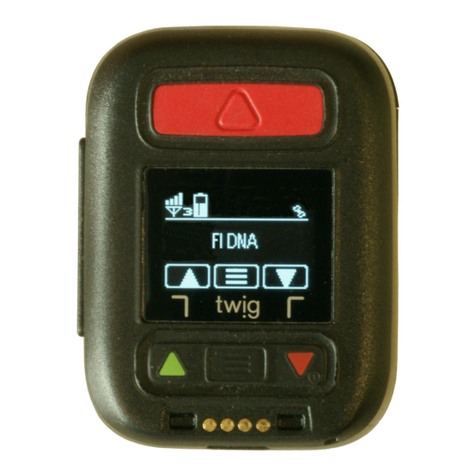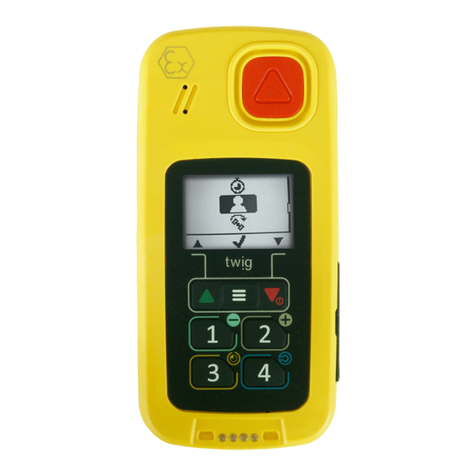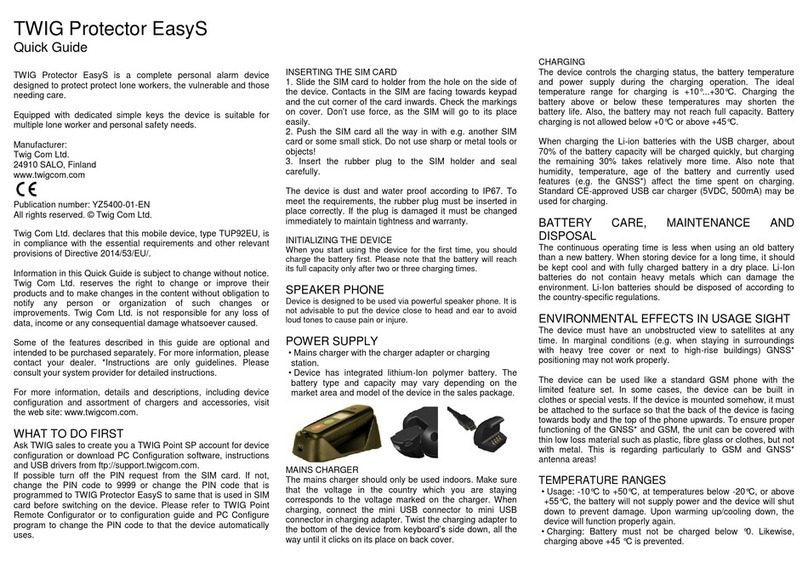
SAFETY AND PRECAUTIONS
TELEMATICS PROTOCOL
MPTP (Mobile Phone Telematic Protocol) allows, among other things, tracking
of the device over SMS or data communication. Automatically sent telematics
messages are only allowed to authorised numbers configured in the device.
Such numbers can be, e.g. emergency and service center numbers. Position
of the device is retrieved by the GNSS*, or by the network parameters or
various radio beacons and networks, the latter is a network dependent service.
The carrier for telematics messages is an SMS message or data connection.
Deliveries of all messages is fully handled by and in the responsibility of the
GSM network operator and services can vary substantially. The charge of a
protocol message is determined on the contract by the service provider.
GNSS/GPS*
The Global Navigation Satellite System (GNSS) is operated by the government
of the United States and other third parties, that are solely responsible for
its accuracy and maintenance. The system is subject to changes that could
aect the accuracy and performance of all GNSS equipment.
EMERGENCY CALLS
The device is an aid and should never be relied upon as an only emergency
device. Its functionality is dependent on GSM network and GNSS satellites
which may not be available all the time. To make emergency calls, the device
must be turned on and located in an area with adequate GSM network signal
strength.
Making an emergency call can also require GNSS satellite coverage and a
valid SIM card. Emergency calls may not be possible on all GSM phone
networks or when certain network services or phone features are in use. In
unclear cases, consult the network operator.
TWIG POINT NETLOC COSTS
The first year of TWIG Point Netloc is free of charge. Please note: TWIG Point
Netloc is not working if the service renewal payment is not made after the
first year free of charge. Twig Com Ltd. does not take any responsibility of
any consequences due to a delay or non-payment of the TWIG Point Netloc
service use after the first year free of charge.
GENERAL
• Trac: Strictly adhere to all eventual European and national legislation and
also honour other eventual safety recommendations when using the device
while driving a vehicle. Place the device in its holder, do not leave it on the
passenger seat or some other place where it can break loose in a collision
or a sudden stop. When receiving a call in an awkward driving situation,
you must always put safety before other priorities and courtesy. If you feel
uncomfortable about using a device while driving, you should not use it.
• Vehicles with air bags: An air bag inflates with great force. Do not place
objects, including either installed or portable wireless devices, in the area
over the air bag or in the air bag deployment area.
• External alert: The use of the alert device to operate a vehicle´s lights or
horn on public roads is not permitted.
• Children: Keep the device and its accessories away from small children
to avoid causing injury to themselves or others. Damage to the device or its
accessories is also thus avoided.
• Power supply: This equipment is intended for use with the specified power
supplies listed in the Quick Guide/Operating Instructions. Any other usage will
invalidate any approval given to this apparatus and may be dangerous.
• Other accessories: Any other accessories used should also be approved by
the device manufacturer. Check the compatibility of new power supply units
and other accessories at the reseller or manufacturer.
• Connections: All installations, connections and service regarding the
device, its power supply and accessories should be approved by the
device manufacturer. Use of any unauthorized accessories, modifications
or attachments may be dangerous and voids the device warranty if said
accessories cause damage or a defect to the device.
• Magnetic fields: The device contains small magnetic components. Even
though the magnetic fields of the components are weak, they might damage
magnetic cards, such as bank and credit cards. We recommend that you
would keep the device away from magnetic cards.
• Storing positions: Position information is stored correctly in the device when
the GPS* is turned o (from the GPS menu) or powered o (by pressing the F2
key). To prevent the memory from becoming corrupted, never power o the
device by removing the battery.
• Neodymium magnets: Some models include strong magnets. Magnets
could aect the functioning of pacemakers and implanted heart defibrillators.
If you wear these devices keep sucient distance to magnets. Warn others
who wear these devices from getting close to magnets. Keep magnets away
from devices and objects that could be damaged by magnetic fields.
• Real-time monitoring: A continuous real-time monitoring may lead to over-
heating of the device and shut it down.
• ManDown impact: Impact function doesn’t work if the device is hitting the
body when carried freely e.g. with carrying strap.
RADIO FREQUENCY (RF) ENERGY
Transmission frequencies and power for TLP50EU device types in EU are
listed in the table below.
Transmitter Max power / dBm
GSM 900 35
GSM 1800 32
WCDMA 1, 8 25
LTE 1, 3, 8, 20, 28 24
SRD*868,218 MHz 5
2.4 GHz WLAN* 20
Bluetooth* 10
#Note: dierent frequencies in Australia!
• Aircrafts: Turn your device o before boarding any aircraft and do not use
the device while in the air. Besides being illegal, the use of a device in an
aircraft may endanger the operation of the aircraft or disrupt the mobile
network. Failure to comply with this instruction may lead to suspension or
denial of mobile phone services, and possibly even legal action.
• Hospitals: Turn your device o before entering hospitals or other health care
facilities where medical electronic equipment may be in use. Such devices
can be extremely sensitive to radio frequency interference. Only use the
device with permission and under the instruction of hospital sta.
• Medical devices: Remember that any personal medical devices (such as
hearing aids or pacemakers) may be aected by RF energy if they are not
adequately shielded. Consult the manufacturer or vendor of the equipment to
determine the proper shielding.
• Posted facilities and country-specific regulations: Power o the device in
any facility where posted notices require to turn o mobile phones. Also follow
all the country-specific regulations applicable to where the device is used.
• Potentially explosive atmospheres: Turn o the device at refuelling points,
e.g. gas stations. Also observe restrictions on the use of radio equipment in
fuel depots, chemical plants or where blasting operations are in progress
because remote control RF devices are often used to set o explosives. Do
not store or carry flammable liquids, gases or explosive materials in the same
compartment as the device, its parts or accessories.
• Other electronical equipment: Using the device may cause interference
with a vehicle’s electronic equipment if it is not adequately shielded. Consult
the manufacturer or the vehicle seller to determine the proper shielding.
• Computers: Remember that using the device close to a computer may
cause interference. When using your device near such equipment keep a
distance of about one meter.
• Body parts: When the device is in operation do not touch the antenna with
eyes, mouth or bare skin to guarantee proper function.
WARRANTY
Twig Com Ltd. warrants to the original purchaser (“Company”) that this
Twig Com device and all accessories originally provided by Twig Com in the
sales package (“Product”) are free from defects in materials, design and
workmanship under normal use in accordance with the operating instructions
and pursuant to the following terms and conditions. Warranty periods are
determined with the purchase agreement
Individual warranty terms and conditions are available from Twig Com or from
local distributor. The warranty is void if the device is opened or the warranty
seal on the screws are tampered.
*Some product versions only.

























